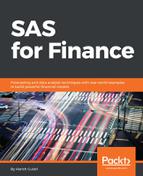Earlier, we introduced the concept of the semi-parametric model and the advantages of using PROC PHREG. Let's conduct a semi-parametric analysis on our survival data. We will use the stepwise methodology (selection option) to introduce the covariates in the model and give inclusion (slentry option) and exclusion criteria (slstay option) to control which covariate can enter the model and on what basis the covariate should be retained in the model. We also add an assess statement to test the proportional hazard (PH option) and linearity assumption (resample option) for the Cox regression model.
Here is the code for the PROC PHREG stepwise regression:
PROC PHREG Data=Survival_Analysis Plots=survival;
Model tenure*censor(1)=Risk_appetite Fund_performance Inv_potential Inv_involvement AUM Complex_prod Complaints
/ Selection=stepwise Slentry=0.25 Slstay=0.15 Details;
Assess var = (Risk_appetite Fund_performance Inv_potential Inv_involvement AUM Complex_prod Complaints) PH / Resample;
RUN;
The initial part of the analysis output lists information about the data and the analysis of effects eligible for entry:

After this, the stepwise process is initiated and variables are entered into the model according to the descending chi-square scores:

The key outputs of the model are the results from the last step of the model (step 4), the summary of stepwise selection, and the survival chart in Figure 6.15. There is one more output that we requested as part of the assess statement. The output that checks for proportional hazard and linearity assumption for all the variables selected in the summary of the stepwise selection is met. The proportional hazard assumption states that the hazard ratio must be relatively constant while comparing strata or variables. Whereas the linearity assumption states that the relationship between the dependent and the independent variables should be significant.
In the analysis of the MLE section in step 4, we can see that the hazard ratio of the variable risk appetite has a p-value of 0.0783, which is not statistically significant at the 0.05 level. The hazard ratios for all other variables in step 4 are significant. Furthermore, while checking for the plot of proportional hazards for risk appetite versus the standardized score process, we can see that around the two and 12-year tenure the observed path deviates from the spread of the simulations. The deviation doesn't seem to be the norm and hence, rather than take a judgment using the plot, we will use the output from the assess statement.
The supremum test for functional form highlights that the linearity assumption isn't met for risk appetite, investment involvement, and complex product variables. All the values are significant at the p<0.05 level. The supremum test for proportional hazard assumptions shows that while all the variables met the assumption, risk appetite barely passed it, as it has a significance just outside the p<0.05 mark.
Since the linearity assumption doesn't hold true for three of the four statistically significant covariates in the model, we cannot use the model in the current form. We should look to transform the current covariates that have failed the linearity assumption or we should drop them while building the model:

The following is a summary of the stepwise selection method:

While checking for the plot of proportional hazards for risk appetite versus the standardized score process, we can see that around the two and 12-year tenure the observed path deviates from the spread of the simulations. The deviation doesn't seem to be the norm and hence, rather than making a judgment using the plot, we will use the output from the assess statement to check the usefulness of the model:

The following diagram shows the proportional hazards assumption for investment involvement. The spread of simulated paths is more consistent than in the case of risk appetite:

Again, in the case of complex products, the spread of simulated paths is more consistent than in the case of risk appetite:

The supremum test for functional form highlights that the linearity assumption isn't met for risk appetite, investment involvement, and complex product variables, as all the values are significant at the p<0.05 level:

The supremum test for proportional hazard assumptions shows that while all the variables met the assumption, risk appetite barely passed it, as it has a significance just outside the p<0.05 mark:

